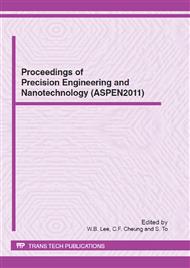p.390
p.396
p.402
p.408
p.414
p.420
p.426
p.431
p.437
Fabrication of Freeform Micro Optics by Focused Ion Beam
Abstract:
In this work, two kinds of freeform micro optics were successfully fabricated by using focused ion beam machining. A divergence compensation method was applied to optimize the machining process. Both dynamic variation of the sputter yield and the extra ion flux contributed by the beam tail were taken into consideration. Measurement results on the surface topography indicated that 3-fold improvement of the relative divergence was achieved for both optics when compared with conventional focused ion beam milling without any corrections. Furthermore, investigations on the influences of scanning strategies, including raster scan, serpentine scan and contour scan, were carried out. The serpentine scan is recommended for the fabrication of freeform optics by focused ion beam technology owing to the minimal beam travelling distance over the pattern area.
Info:
Periodical:
Pages:
414-419
Citation:
Online since:
June 2012
Authors:
Price:
Сopyright:
© 2012 Trans Tech Publications Ltd. All Rights Reserved
Share:
Citation:


